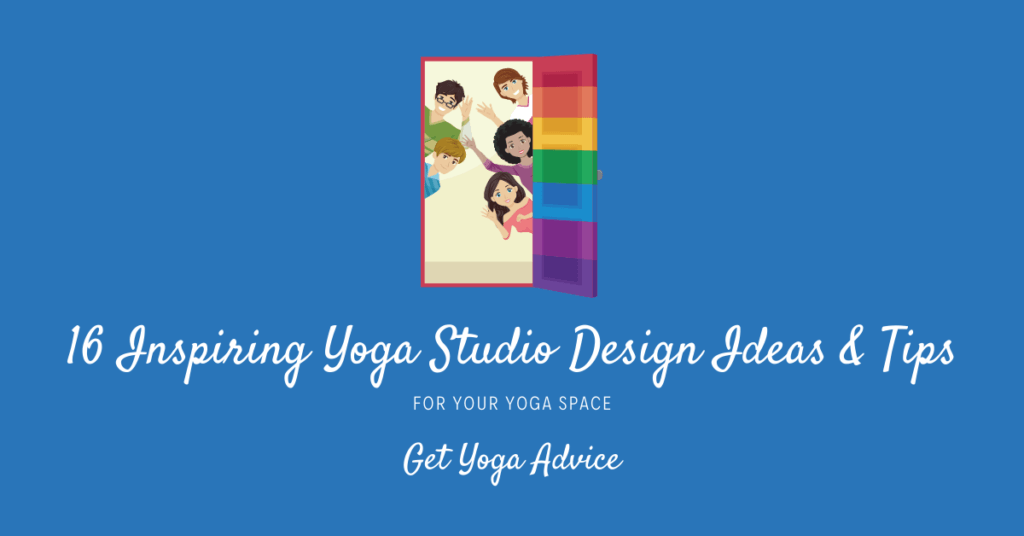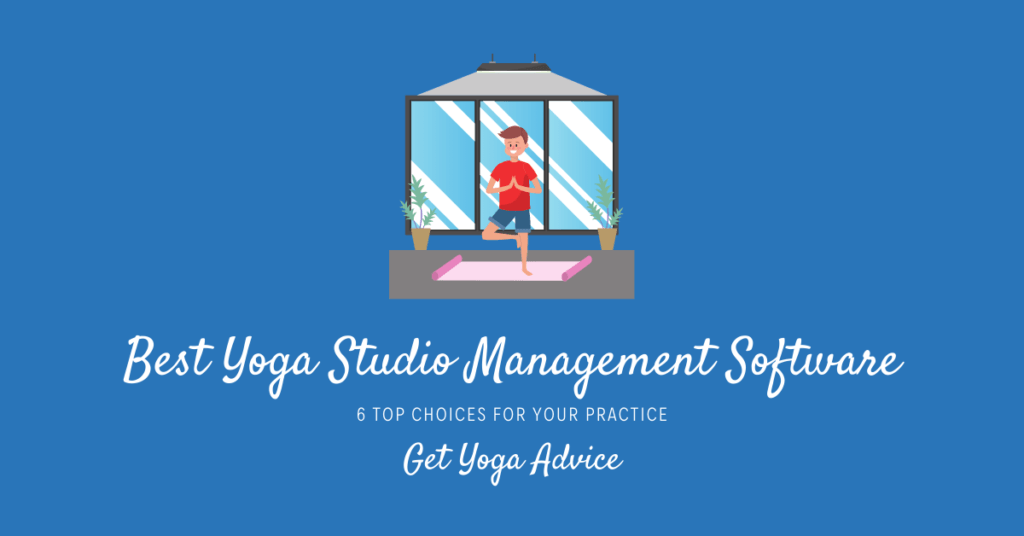There’s a lot to think about when setting up a yoga studio: budget, advertising, class schedules, employee schedules. Sometimes, it seems like the list never ends. One thing that shouldn’t be overwhelming for your yoga business is the design process.
There are plenty of ways to make it fun and rewarding, even if you can’t afford to hire an interior designer.
If you’re not sure what direction you want to go or if you’re worried about your budget, here are 16 yoga studio design ideas and tips for your yoga space.
- 1. Figure Out Your Perspective
- 2. Choose a Design Theme For Inspiration
- 3. Look For Inspiration Everywhere You Go
- 4. Stick to Your Budget, But Get Creative
- 5. There Are Some Places Where You Can’t Cut Corners
- 6. Give Yourself Room to Expand
- 7. Treat the Reception Area as its Own Space
- 8. If You Have Space, Create a Lounge Area
- 9. Don’t Forget the Amenities
- 10. Work Your Retail Display Into the Design.
- 11. The Exterior is Just as Important as The Interior
- 12. Add an Aquarium for a Bit of Extra Zen
- 13. Don’t Forget About Outdoor Spaces
- 14. Add a Mirror Wall
- 15. Use Wooden Beams and Boards to Add Natural Elements
- 16. Make the Most of the Space You Have
- Final Word on Yoga Studio Design Ideas and Tips
Contents
- 1 1. Figure Out Your Perspective
- 2 2. Choose a Design Theme For Inspiration
- 3 3. Look For Inspiration Everywhere You Go
- 4 4. Stick to Your Budget, But Get Creative
- 5 5. There Are Some Places Where You Can’t Cut Corners
- 6 6. Give Yourself Room to Expand
- 7 7. Treat the Reception Area as its Own Space
- 8 8. If You Have Space, Create a Lounge Area
- 9 9. Don’t Forget the Amenities
- 10 10. Work Your Retail Display Into the Design.
- 11 11. The Exterior is Just as Important as The Interior
- 12 12. Add an Aquarium for a Bit of Extra Zen
- 13 13. Don’t Forget About Outdoor Spaces
- 14 14. Add a Mirror Wall
- 15 15. Use Wooden Beams and Boards to Add Natural Elements
- 16 16. Make the Most of the Space You Have
- 17 Final Word on Yoga Studio Design Ideas and Tips
1. Figure Out Your Perspective
Most yoga studios have a specific focus, something that drives the students and gives the studio its energy. Before you can really settle on a design style, it helps to figure out your perspective.
There are a lot of things you can focus on, including spiritual perspectives, like healing, tranquility, or balancing the mind and body in a sacred space, or a more specific fitness studio approach, such as weight loss, rehabilitation, or flexibility.
Some studios focus on different types of students and offer gender-specific classes or yoga for kids. Others, like a hot yoga studio, offer specific types of classes that guide their perspective. What are you hoping to accomplish in your yoga space?
You don’t have to base your entire decorating scheme on this, but it is helpful to keep it in mind as you move forward. For example, if you’re teaching kids classes, you don’t have to make your studio look like a studio for kids, but adding some bright yoga mats or bolsters is an easy interior design touch.
You might also find these yoga marketing phrases to promote your yoga classes helpful.
2. Choose a Design Theme For Inspiration
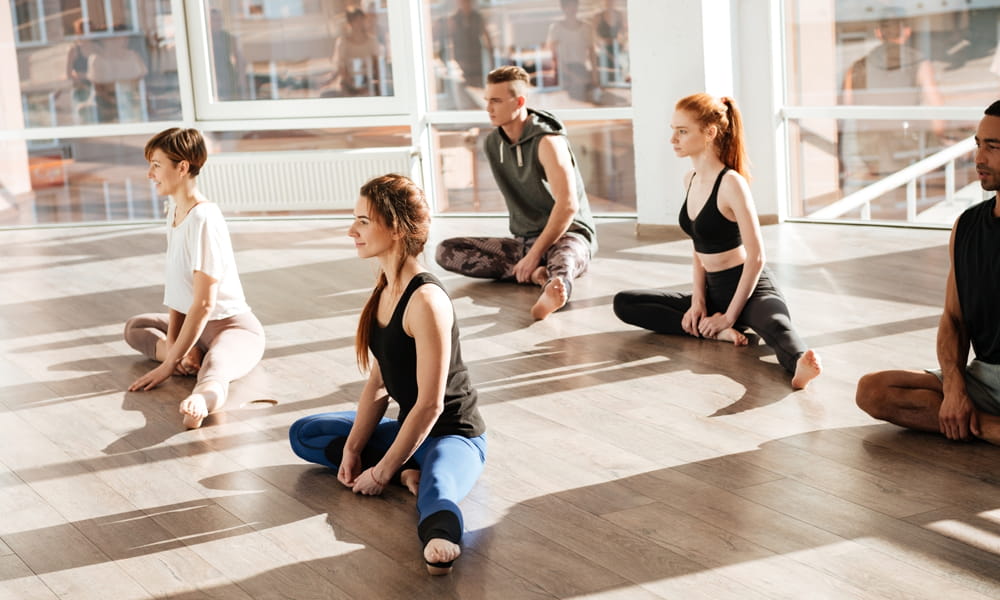
Think about the spaces that make you feel the way you want to in your yoga studio. Do you feel calm when you’re exploring nature? Do pastel colors help your mind focus? Are you able to meditate best in a clean, uncluttered space?
Use these feelings to create a design theme. Bring the outdoors in with natural lighting, plenty of plants, wood accents, neutral colors and white walls.
Or, you could go for an interior design theme that’s completely different, and paint the walls bright, invigorating colors to energize the room. Try an urban, industrial feel with brick and steel or keep it simple with a minimalist design using bright lights and neutral colors.
3. Look For Inspiration Everywhere You Go
Visiting other yoga studios, spas, and wellness spaces is a great way to get ideas, but don’t limit yourself to these spaces.
Look at travel, architecture, design, and art magazines. Watch redecorating shows on television to get some ideas about how various design elements work together. Browse the fabric section of your local craft store and see if anything jumps out at you.
4. Stick to Your Budget, But Get Creative
Don’t think that you can’t put together an inspiring yoga studio if you’re trying to stick to a modest budget. Sometimes, all it takes is the right color paint to change the entire look of a room.
A colorful wall hanging makes a big impact, and adding window sheers changes the way the natural light filters into the room. Paint a big mandala on the wall or the floor as a focal point. Add some cool floor lamps for ambient light.
Hit up thrift stores, yard sales, and estate sales for interesting pieces, like mirrors, vases, and lamps. You might need to spend some time cleaning or refinishing some items, but you can find some amazing pieces if you take the time to look.
5. There Are Some Places Where You Can’t Cut Corners
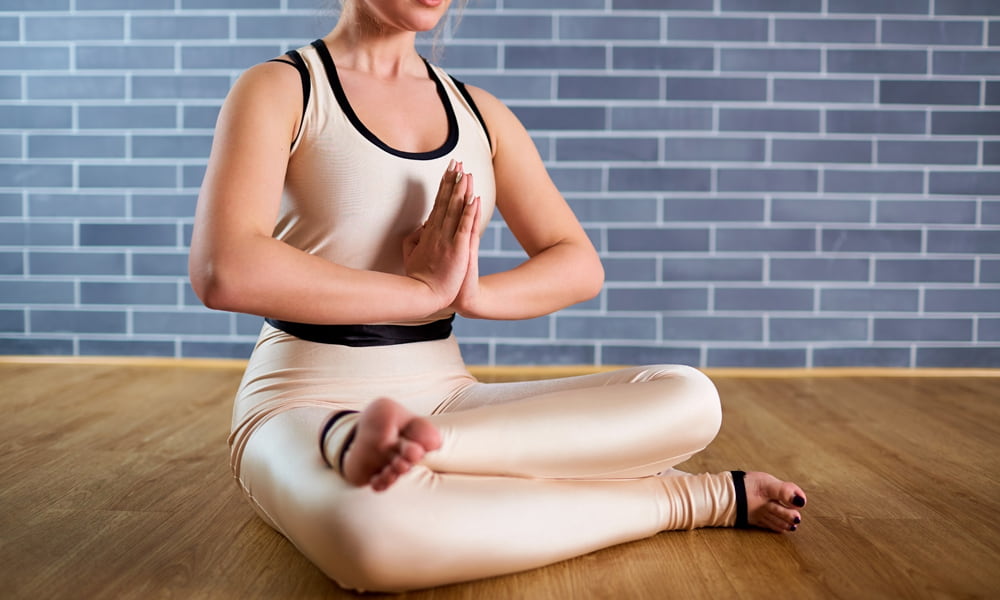
There are areas in your yoga studio space where it’s worth investing a little more to save money in the wrong run. Nice flooring is important for any yoga studio. Hardwood is about as good as you can get, but bamboo or laminate are great, too.
If you’re going to host more than one class at a time, make sure you have the classes properly separated from each other and the reception area. You don’t want people waiting for the next session to have to wait outside or stand in the back of the class space. It’s disruptive to the class that’s in session and awkward for those waiting.
6. Give Yourself Room to Expand
It’s difficult deciding how much space you need in the beginning. On one hand, you want costs to be as low as possible. On the other hand, if you plan to expand in the near future, it makes sense to work it into your design plans.
Are you planning to add a retail area where you can display your merchandise? A juice bar? Snacks? What about larger expansions, like a massage area or sauna? You don’t have to do everything all at once, but design the rest of the space around what you hope it will be in the future.
7. Treat the Reception Area as its Own Space
The reception area should be separate from the area where classes are taught but don’t forget that it’s an important part of your studio. At a minimum, it should have a reception desk where you can stand to greet customers and process payments. Class schedules should be clearly posted, as well as prices for each class.
If you’re planning to sell memberships or special packages, this information should be on display, too.
Give students a place to sit or a decent amount of space to stand. You should also have an area where students can hang their coats and store shoes and jackets. If not, the classroom area will be cluttered with belongings, especially in the cooler months.
8. If You Have Space, Create a Lounge Area
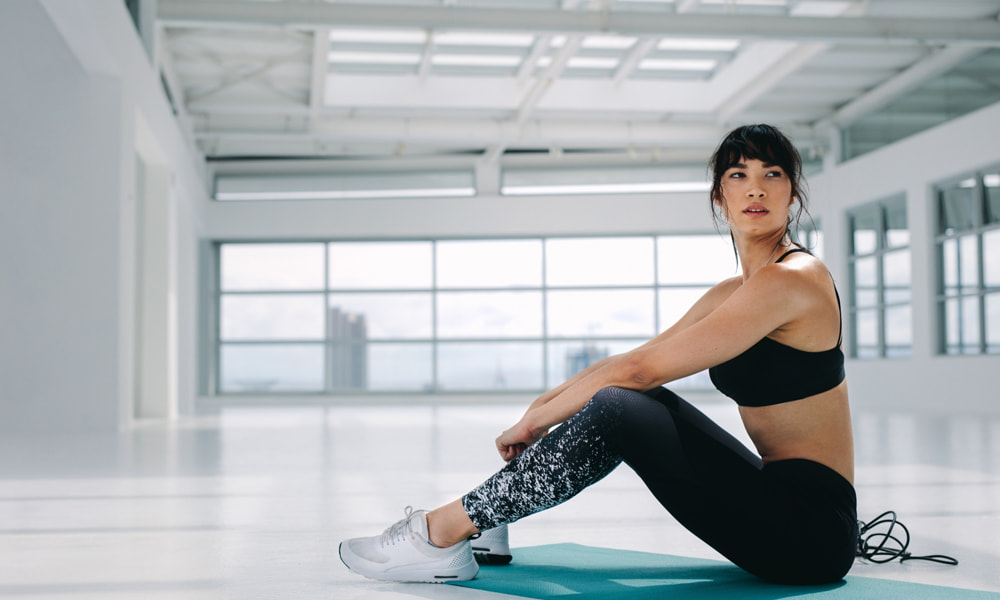
A sitting area is a nice addition to any yoga studio. It gives students a place to sit and chat while they wait for the class to begin in the yoga room, and they may even hang out after class.
Don’t take up too much space for a lounge, but if you have room to spare, it’s a great investment – especially if you sell juice and snacks. Having a place to sit and enjoy a treat after class with friends is a big draw.
9. Don’t Forget the Amenities
There’s a practical side to design that can’t be overlooked. If you don’t have a powder room in your studio, make sure there is one close by. Some spaces share public restrooms with other businesses in the building, which is fine.
If you are lucky enough to have one in your studio, make the most of it. Make sure the decor matches the rest of the studio, and add advertisements for upcoming classes on the wall or right outside the door.
It’s not always possible, but locker space is a nice thing to offer students. It gives them a safe space to store their belongings during class and keeps the studio from being cluttered with bags, jackets, and shoes.
10. Work Your Retail Display Into the Design.
One way to expand your business is by creating a retail space in the reception area. This can be something as simple as a bookshelf with a few items for sale or as big as a full counter and display case full of yoga gear. If you choose the right items, this type of setup can bring in a decent amount of revenue.
Branded materials are always best, so have some tee-shirts, yoga mats, and yoga towels made with your studio’s logo. You can also sell more general items, like magazines, DVDs, books, incense, supplements, candles, or anything else that suits the vibe of your studio.
11. The Exterior is Just as Important as The Interior
There are some things you can do on a budget when you’re designing your yoga studio, but the exterior sign is not one of them.
The signage is the first thing people will see and it says a lot about what they can expect when they walk into your studio. Hire a professional to create something that matches the style of your studio, whether you’re having a hanging sign made or sticking with something simpler, like window lettering or a decal.
12. Add an Aquarium for a Bit of Extra Zen
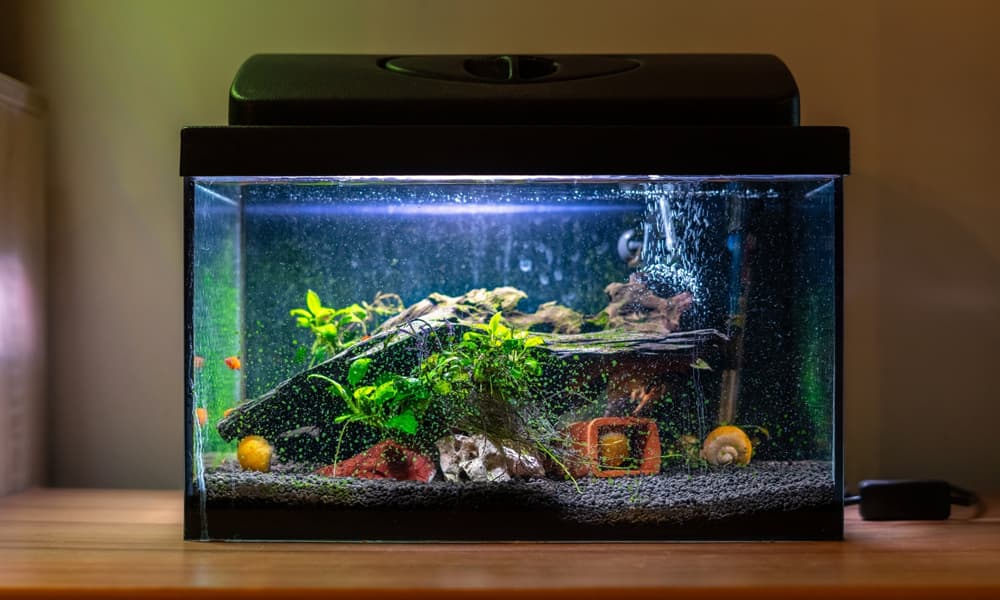
Aquariums are a calming addition to any room. The sound of the water flowing, green plants, and a few colorful fish swimming around are ideal for a yoga studio. Start with a small betta tank or a larger tank with some smaller schooling fish, but make sure you do your research. Aquariums do take a bit of work.
Alternatively, if you have the budget, you can hire a professional to set up a larger saltwater tank and keep coral and tropical fish. Keeping a large saltwater tank is a lot of work, so it’s better to hire someone to get it up and running and to maintain it for you.
13. Don’t Forget About Outdoor Spaces
While this isn’t possible for everyone, if you have an outdoor space at your studio, make the most of it. There’s nothing like outdoor yoga, and if you have a space to do it, you should. If you have a small outdoor area, set up a canopy, play calming music to drown out any noise, and lay down a nice, thick rug.
If you have a little more space, build a gazebo or pergola and drape neutral fabric over the beams. Build a raised floor or deck if you can as it creates a better atmosphere than an ordinary concrete slab.
In most climates, you won’t be able to keep the outdoor setup year-round, and you’ll have to make sure you watch the weather and bring in rugs and other things that could get ruined by inclement weather.
But in the spring, summer, and early fall, adding an outdoor element to your classes is a great way to attract clients. Make it a sacred space and use it wisely.
14. Add a Mirror Wall
One way to make a small space seem larger is to use mirrors, and the most impressive way to do so is to make an entire wall with them. You don’t want to overdo it, so stick with only one wall. It adds just the right amount of ambiance and helps students keep an eye on their form as they work on new poses.
15. Use Wooden Beams and Boards to Add Natural Elements
If you’re lucky enough to find a studio space with wooden ceiling beams, make the most of them. If you don’t and you have a decent budget, talk to a contractor about adding them if you really love the look.
Another way to bring wood into a space is wood paneling. We’re not talking about the dated wood paneling you found your grandma’s basements 30 years ago. Modern wooden paneling is much more stylish. Some peel and stick to the walls or you can use laminate floorboards and install them vertically instead.
16. Make the Most of the Space You Have
It’s not always possible to do big renovations or make major changes, and that’s okay. Take a look at the space you do have to work with. What makes it special? Are there any interesting nooks and crannies you can use to add interest?
If the best feature is the big front windows and an abundance of natural light, use it. Have awesome hardwood floors? Make the most of it. It’s great to go all-in with studio designs if you can, but you don’t have to go broke to make your yoga studio work.
Final Word on Yoga Studio Design Ideas and Tips
If you have a home yoga studio or are a yoga studio owner, you have a lot to think about, but don’t let decorating your studio stress you out. Putting together the look and feel of your studio should be fun and rewarding, and we hope we gave you a few ideas to bring in some good vibes.
You might also find our tips for owning a yoga studio helpful.

